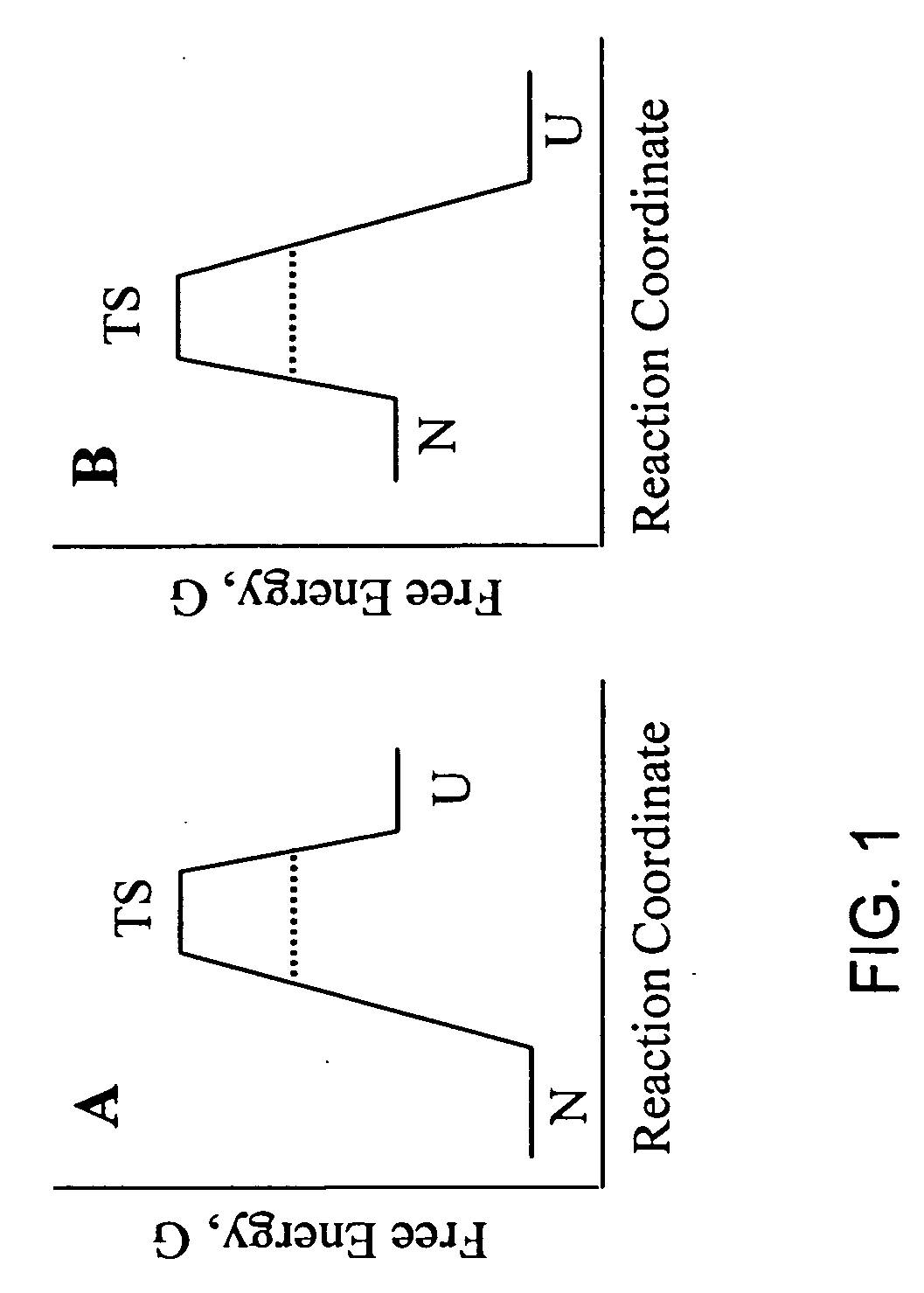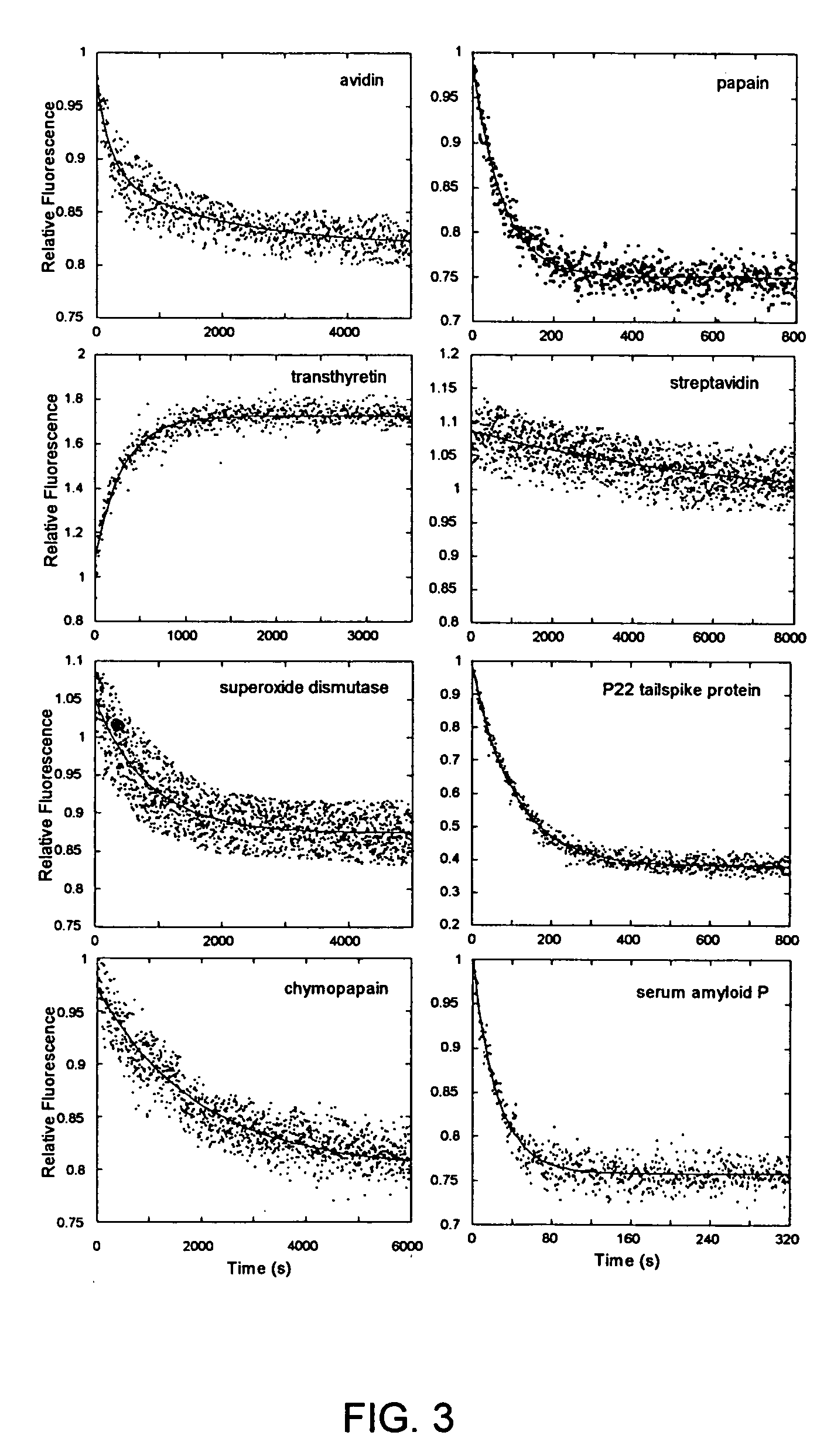Methods of identifying kinetically stable proteins
- Summary
- Abstract
- Description
- Claims
- Application Information
AI Technical Summary
Benefits of technology
Problems solved by technology
Method used
Image
Examples
example 1
[0060] SDS-polyacrylamide Gel Eectrophoresis (SDS-PAGE) Assay. Lyophilized proteins were obtained from Sigma (papain (PAP), chymopapain (CPAP), avidin (AVD), and superoxide dismutase (SOD)) and Calbiochem (streptavidin (SVD), serum amyloid P (SAP), and transthyretin (TTR)). Salmonella phage P22 tailspike (TSP) protein was a gift from J. King (MIT). All the remaining proteins (Table 2) were obtained from Sigma with the exception of catalase, which was purchased from Calbiochem. Stock solutions (1 mg / mL) of all proteins studied except papain, chymopapain, and P22 tailspike protein were made using 10 mM sodium phosphate buffer (pH 7.0) (PB). Stock solutions (1 mg / mL) of papain and chymopapain were prepared with 25 mM 2-amino-2-hydroxymethyl-1,3-propanediol (Tris), 1 mM EDTA (pH 5.3). The stock solution of the P22 tailspike protein was 0.8 mg / mL in 50 mM Tris, 2 mM EDTA (pH 7.6). All electrophoresis samples contained ˜5 μg protein and 1% sodium dodecyl sulfate (SDS) in 0.125 M Tris (pH ...
example 2
[0061] Proteolysis. For limited proteolysis experiments the concentration of the proteins was determined by weighing the lyophilized protein on a microbalance. Each proteolysis reaction mixture contained about 0.5 mg / mL protein and 5 μg / mL proteinase K (Fisher Scientific) in 25 mM Tris, 1 μM EDTA (pH 8.3), and was incubated at 25° C. for 48 hours. The reaction was stopped with a solution of 2.5 μM phenylmethylsulfonyl fluoride, 4% SDS in 0.125 M Tris, 3.4 μM 1,4-Dithio-DL-threitol (pH 6.8)). Samples were boiled and gel electrophoresis was performed using 16% acrylamide Novex precast gels (Invitrogen). Running buffer was 0.1% SDS in Tris / Tricine buffer (pH 8.1).
example 3
[0062] Fluorescence. Unfolding kinetics induced by guanidine hydrochloride (GdnHCl) were monitored using an F-4500 fluorescence spectrophotometer (Hitachi, Danbury, Conn.). The concentration of GdnHCl was determined using an Abbe Mark II refractometer (Leica, Buffalo, N.Y.). Protein solutions (0.05 mg / mL) in 25 mM PB, 0.20 M sodium chloride (pH 7.2) were treated with GdnHCl solution made using the same buffer to a final concentration of 6.6 M. The excitation / emission wavelengths used were: 275 / 350 nm (B2M), 275 / 360 nm (BLA, ConA, GAPDH, TIM), 280 / 320 nm (ADH), 295 / 360 nm (CPAP, TTR), 295 / 350 nm (PAP), 295 / 340 nm (SAP, TSP), 280 / 330 nm (SOD), 295 / 333 nm (SVD), and 280 / 340 nm (AVD). Kinetic traces were analyzed by fitting to a sum of exponentials.
PUM
| Property | Measurement | Unit |
|---|---|---|
| Electrical resistance | aaaaa | aaaaa |
| Stability | aaaaa | aaaaa |
| Plasma power | aaaaa | aaaaa |
Abstract
Description
Claims
Application Information
 Login to View More
Login to View More - R&D
- Intellectual Property
- Life Sciences
- Materials
- Tech Scout
- Unparalleled Data Quality
- Higher Quality Content
- 60% Fewer Hallucinations
Browse by: Latest US Patents, China's latest patents, Technical Efficacy Thesaurus, Application Domain, Technology Topic, Popular Technical Reports.
© 2025 PatSnap. All rights reserved.Legal|Privacy policy|Modern Slavery Act Transparency Statement|Sitemap|About US| Contact US: help@patsnap.com



